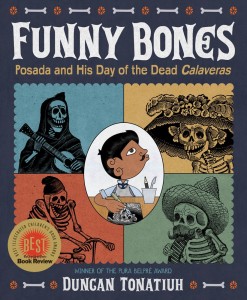 You know that skeleton woman with the big flowered hat? Guess what? Her name is la Catrina, and she wasn't created by Russell Stover. You may not recognize the name José Guadalupe Posada, but you're probably familiar with his most iconic illustration. La Catrina is everywhere these days, especially since el dia de los muertos has become so fashionable in the U.S.
You know that skeleton woman with the big flowered hat? Guess what? Her name is la Catrina, and she wasn't created by Russell Stover. You may not recognize the name José Guadalupe Posada, but you're probably familiar with his most iconic illustration. La Catrina is everywhere these days, especially since el dia de los muertos has become so fashionable in the U.S.
In Funny Bones: Posada and His Day of the Dead Calaveras, Duncan Tonatiuh pays homage to the life and work of Posada. Tonatiuh takes his digital collaging of images a step further as he combines his own illustrations with details from Posada's prints. In addition to his now-famous high society skeleton woman, Posada is recognized for his use of etching, lithography, and engraving to create cartoons that were often critical of politicians and the upper class in pre-Revolution Mexico. While the styles of the two artists differ, Tonatiuh has managed to integrate Posada's images into his own to create an appearance that is part past, part present, and entirely unique.
The extent to which Tonatiuh adds his own touches varies from page to page. The first image we see is a two-page collage of Posada's black-and-white skeleton prints, to which Tonatiuh has added some color. In other illustrations we see Posada's work collaged into Tonatiuh's. There are broadsides with Posada images held in the hands of original Tonatiuh characters and Posada skulls superimposed on Tonatiuh's break dancers and skaters. Other illustrations consist solely of Tonatiuh's original hand-drawn images. There are several double-page spreads that juxtapose Tonatiuh's original work, in a recognizable earthy palette, with Posada's black-inked prints on a single solid color combined with Tonatiuh's text to give the appearance of a one-page broadside from the early twentieth century.
Duncan Tonatiuh's illustration style is a little bit like a time machine. Through its now recognizable characteristics — the ears that curl into what looks like the number three, the people drawn in side profile that gives a sense of scrolling through images in the same way one might have scrolled through an accordion-folded Mixtec codex created on animal skin — Tonatiuh has brought pre-Columbian art onto the radar of the picture book world. In Funny Bones, he uses his signature style to bring the art of another Mexican historical subject to the mainstream.
Who would ever have conceived that children's librarians, book reviewers, and award committees would one day be using the terms "pre-Columbian" or "Mixtec codex" or the name Posada in writing about and discussing picture books? I hope those terms are being tossed around among this year's Caldecott committee members. But does Funny Bones have a chance? That may, in part, depend on how the committee interprets the term "original work." Funny Bones combines one artist's original illustrations with the work of another artist whose images are now, for the most part, in the public domain. Caldecott terms and criteria define original work as being "created by this artist and no one else." Tonatiuh's illustrations, the collages that include Posada's skeletons, are original work in their final published form. But will the fact that the illustrations incorporate Posada's prints influence how the committee looks at the originality factor? I’d like to be a fly on the wall in that conference room.
Posada died in poverty in 1918. His artwork remained in obscurity until it was rediscovered years later by other artists, including Diego Rivera, whose 1947 mural Sueño de una tarde dominical en la Alameda Central (Dream of a Sunday Afternoon in Alameda Central Park) prominently features la Catrina. More than one hundred years after his death, Posada's skeletons have become a part of popular culture. Perhaps some Caldecott recognition this year for Tonatiuh and Posada?
ALREADY A SUBSCRIBER? LOG IN
We are currently offering this content for free. Sign up now to activate your personal profile, where you can save articles for future viewing.








Add Comment :-
Be the first reader to comment.
Comment Policy:
Comment should not be empty !!!